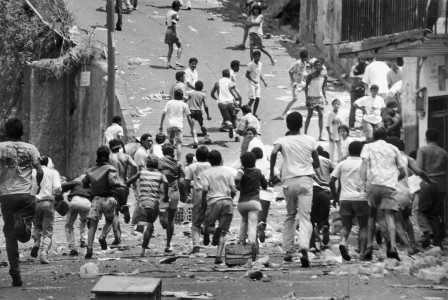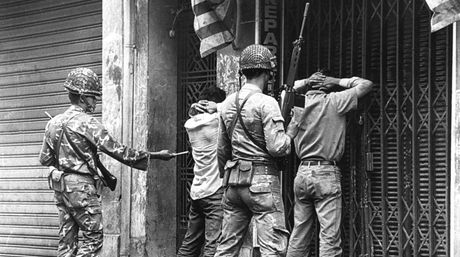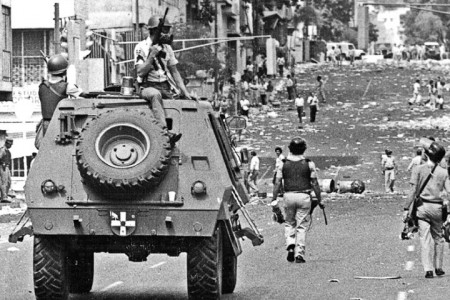Originally appeared in http://www.telesurtv.net/telesuragenda/La-masacre-de-El-Caracazo-20150224-0032.html
Translated by Lisbeth Mechter for SouthFront
Between February 27th and March 6th, 1989, the (Venezuelan) Army and the Police used about 4 million bullets to repress the people, who hungry and poor, went out to the streets to claim their rights. This massacre is known as “El Caracazo”.
“I entered to Tiuna Fort and I had to see it at war. I was looking for gasoline with a godfather who was a colonel. I sat in his office and watched that disaster on the TV. I went to the yard and there were soldiers running, officers calling to formation and looking for rifles. And I told him: My colonel ¿What are you going to do? -Oh Chávez, I don’t know what`s going to happen here! But the order that arrived is that all troops must go out to the streets to contain the people.
How do you mean that you are going to contain them? –With rifles and bullets if necessary, he said. God be with us, but that’s the order.
I saw the soldiers going out, logistics soldiers who are not so well-trained, they are the ones that prepare the food, the ones who are in charge of the vehicles, even the mechanics were taken out and given a rifle, a helmet and enough ammunition. What was about to come was a disaster, so it was”.
Hugo Chávez
In that way, Commander Hugo Chávez described what he saw on February 27th, 1989, a day that remains in the history of Venezuela, the day in which the people from one of the richest countries of the world, the fifth world’s oil reserve, upraised against a system which had condemned them to poverty and no hope.
For Venezuelans “El Caracazo”, also called “El Sacudón/The Big Shake” was the day when “people came down from the hills”, that’s how the humblest neighborhoods in the capital are known. On February 27th and 28th there was a wave of pillages in the country, especially in supermarkets, butcher shops and home appliances stores. We can’t forget that we are talking about a Venezuela whose 62% of the total population was deeply poor.
“El Guarenazo”, the beginning
On February 27th and 28th, an unprecedented, spontaneous social burst took place in one of the most important cities in Venezuela after a series of neoliberal economic measures recommended by the International Monetary Fund (IMF), applied by the President Carlos Andrés Pérez.
Most of times we talk about “El Caracazo”, but the protests actually started in Guarenas, in Miranda state, located about 15 kilometers to the east of the capital Caracas; but these protests spread to the main cities of the country.
The increase in the cost of the public transportation was the cause for the popular uprising because the members of the transportation sector wanted to increase the price in 50th when it was only allowed to do it in a rate not superior to the 30%, which by the way was already a big impact for Venezuelans’ economy. Besides that the 50% benefit in the price for students would also be suppressed.
Another factor for the popular revolt was the hoarding and speculation of basic need products, which originated shortages and inflation. For that reason, after the initial reaction against the transportation sector, the action spread to the supermarkets and smaller stores, in whose storages, Venezuelans found many of the products that were highly limited by then, like: milk, sugar, coffee, flour, oil, sardines, among others.
It was for that reason that on February 27th, people from Guarenas started a massive popular demonstration.
“We never intended, in any moment, any kind of pillage, we just wanted to make a proposal for the transportation sector to be conscious and charge the increase approved by the Autonomous Service of Transportation and Land Transit, which was of the 30 %, but they wanted to charge an extra 50%”, Eleazar Juárez says, who was Secretary General of the Federation of Associations of Neighbors of Plaza Municipality (Fedeplaz), organism that led the protests that day.
Till 02h00 (local time) of that day, Juárez and members of Fedeplaz, which encompassed over 68 organized communities, were printing flyers that supported the protest against the strategy of the transportation sector. That day, they went out very early in the morning to take the bus station of Guarenas and make their voices heard.
However, according to his story, the main parties of the country: Acción Democrática (AD, in power by then) and the Independent Committee of Political and Electoral Organization, sent a group of people to thwart their way to the City Council. “They responded to the parties’ interests”, Juárez says.
“There they came the groups of AD, coming from Guatire and Petare, and they wanted to break it up (the protest), but the Federation was defending its position, and had people by its side”, he added.
Then, the President of the City Council ordered the Metropolitan Police to dissolve the cited demonstration of about 4 000 people, to which the officer in charge said it was not possible, because “there are more than 4000 people there”. The officer responded “You accomplish the order, then complain”. So, the officer took his 9mm out and shot to the air, Juárez remembers.
When the group headed to the City Council, at noon of that day, the pillages had already started.
According to the version of Eleazar Juárez, some militaries started the pillages. “As the events on Higuerote were taking place, trucks of the National Guard arrived, as everything was locked away, they tried to find a way out. When the armed contingent was passing by a slaughterhouse, they stopped their vehicle and loaded it with meat and they told people –if you want, take this (the meat) to your house…then, the pillages started in Guarenas”.
*The data of the interview was taken from a special published on 2012 by the Orinoco Post.
El Caracazo
In the morning hours of February 27th, 1989, the popular revolt originated in Guarenas headed the Venezuelan capital. In the afternoon, all the stores in Caracas were closed and there wasn`t transportation service.
In the night the pillages started in different kind of stores, like: supermarkets, groceries stores, liquor stores, butcher’s shops, furniture and home appliances stores, among others. Men, women, children elder people and some violent groups, took part in the events.
Military and Police forces were already deployed in the capital, but the repression hadn’t started yet, it was limited to preventive actions. However, that day, the first victim appeared. Yulimar Reyes, Student of Literature of the Central University of Venezuela was murdered in the hallways of the Central Park (downtown Caracas) by a police officer who shot her in the face and neck.
On February 28th, the Government of Carlos Andrés pPérez reacted against the pillages with the plan “Ávila”, through which he ordered the National Guard and the Army to contain the rebellion, allowing them the use of weaponry. Thus, the brutal repression of the citizens started.
Pérez also established the state of emergency, as it’s stated in the article 4240 of the Constitution of 1961, suspending all the constitutional guarantees. So, the rights of liberty and personal safety, the non-violation of domestic home, free transit, liberty of speech, public gatherings and the right to protest peacefully were suspended for ten days. This measure increased repression.
The Executive sent 4000 soldiers with tanks to the streets of Caracas aiming to reestablish the order. According to witnesses, the first groups of militaries were deployed in the base of the hills to avoid that more people could continue coming down to join the pillages. The first gunshots were or warning, but then they started to murder people.
Even when the pillages had ceased, the militaries continued firing indiscriminately against the houses and its inhabitants in the most popular zones of Caracas. Also, Army patrols started to inspect houses in the cited neighborhoods to apparently look for the stolen merchandise and arrest the suspects.
Witnesses claim that during February 27th and 28th, the sound of rifles and machineguns echoed in Caracas, and when the shooting stopped, morgues were full of corpses and hospitals were not enough to assist the massive amount of injured people.
According to official information, the events of late February and the beginning of March, 1989, left about 300 fatalities and over a thousand wounded, but extra-official information claims that there were about 2000 dead people, thousands of injured and a non-determined number of disappeared people. Also, huge economic and material losses were reported.
On March, the president Carlos Andrés Pérez put an end to the curfew, but ordered the Congress to maintain the State of Emergency and some constitutional guarantees were restored.
The massacre
In the Southern General Cemetery, in the west of Caracas, there’s a section called “La Peste” (The Pest), because during “El Caracazo”, the bodies of dead civilians, murdered in the neighborhoods were taken and left there for several days before been buried in mass graves.
In “La Peste”, authorities recently found a mass grave with 70 unidentified bodies. They were not included in the official list of the government of Carlos Andrés Pérez.
Justice
In 1998, a decision of the Interamerican Court of Human Rights ordered the Venezuelan State to indemnify the relatives of only 45 of the families of people killed in the popular revolt.
The number of fatalities, injured and disappeared people is still unknown. Despite the events happened several years before his presidential term, the government of the president Hugo Chávez recognized the responsibility of the Venezuelan State and in 2006, by means of the Ministry of the Interior and Justice, he announced mechanisms to also indemnify the victims who had no access to the Interamerican Court as well.
On February 27th, 2013, the National Assembly (NA, Parliament) created a commission to investigate the performance of police officers and militaries in the events of 1989, which, according to official data left 276 dead, as some claim that the number of disappearances could reach 1000-2000.. That same year the Prosecutor accused Virgilio Ávila Vivas (Governor of the capital District in 1989) for his responsibility in the massacre. The judgment against him started in 2014.









